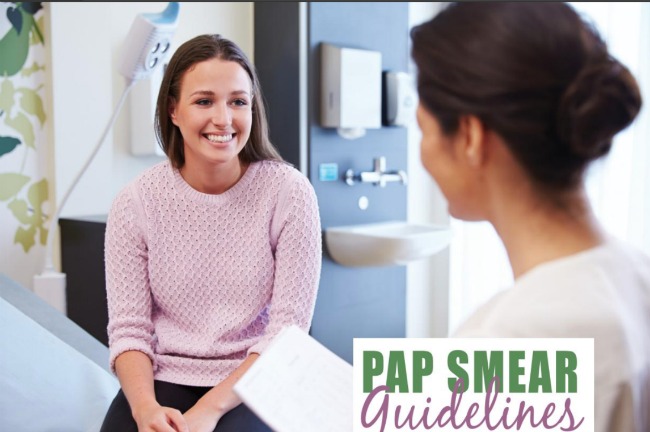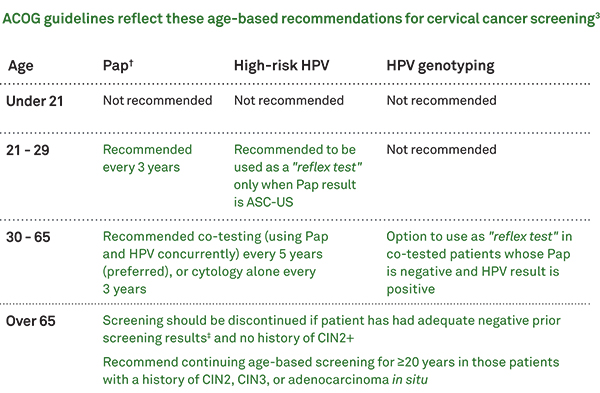Pap Smear Guidelines
by Kassandra Patton, WHNP / Kalispell OB/GYN

When you schedule your annual well-woman exam, you may be surprised to find that your visit does not always include a Pap smear. Current recommendations on this once yearly screening have changed much over the past 5 years. But first, let’s start with the basics:
What Exactly is a Pap smear?
Pap smear is actually short for “Papanicolaou” smear, which was named after Georgios Papanikolaou, the Greek doctor who invented the test. This is a method of cervical screening which is used to detected precancerous or cancerous changes to the cervix. The cervix is the opening to the uterus, or womb. The cervix is seen by inserting a special instrument into the vagina called a speculum that allows the provider to visualize the cervix and surrounding tissues. A small sampling of the cervix is then gathered using a soft brush to sweep cells off of the surface of the cervix. This sampling is then sent to the lab to be viewed under a microscope to look for any suspicious changes. The results are then sent back to your provider for review. Your provider may also have this sample tested for presence of a specific virus that causes cervical cancer called the human papilloma virus or HPV
What is HPV and how does this affect me?
Cervical cancer is one of a small handful of cancers that is actually caused by a virus. That virus is called the human papilloma virus or HPV. There are over 200 strains of HPV that have been identified with each having it’s own number. HPV’s 6 and 11 are considered low risk and are responsible for the vast majority of warts that can appear on and around the genitals.
High risk HPV’s are responsible for almost all cases of cervical cancer. There are around one dozen high risk strains of HPV, but two of these strains, 16 and 18, are responsible for approximately 90% of HPV related cancers which include cervical, anal and throat cancers. HPV is spread through sexual contact. It is estimated that between 80-90% of people who are sexually active would test positive for at least one strain of HPV.
Most high-risk HPV infections occur without any symptoms, go away within 1 to 2 years, and do not cause cancer. Some HPV infections, however, can persist for many years. Persistent infections with high-risk HPV types can lead to cell changes that, if untreated, may progress to cancer.
Another risk factor for cervical cancer is smoking. Smoking lowers your natural immune system making it harder for your body to fight off an HPV infection. Obviously it is not recommended to smoke cigarettes, but if you are found to have a high risk HPV strain, it becomes even more urgent to kick the habit. Talk with your doctor about available programs and medications that can help you to stop smoking for good.
When should I get a Pap smear?
You should always talk with your doctor to determine the proper timing of your Pap smear. For the general population, the American Congress of Obstetricians and Gynecologists (ACOG), have guidelines in place for timing of Pap smears and HPV testing:

Many women wonder: “If I don’t need a Pap smear every year, do I need to see my doctor every year?” The answer is “Absolutely!”
The Pap smear is only one small part of a female wellness exam. Your provider is also performing a complete physical exam including a breast exam and pelvic exam. Evaluation of menstrual cycles as well as birth control or fertility plans are also reviewed during an annual exam. Most insurances will also cover this visit with your provider at little to no cost as it is a preventative and wellness visit. If you do not have insurance and meet certain household income qualifications, Pap smears may be available at no cost through the Health Department.
There are no excuses for missing your annual exam
If you have been putting off this important screening, contact your provider to schedule your annual wellness screening today!
Kassandra Patton, WHNP joined Kalispell OB/GYN in March 2013, moving to Montana from Illinois with extensive experience as a women’s health nurse practitioner. Kasey has a strong interest in teenage wellness exams, reproductive health, and contraception management.
Follow other women’s health blogs at 406 Woman Magazine
